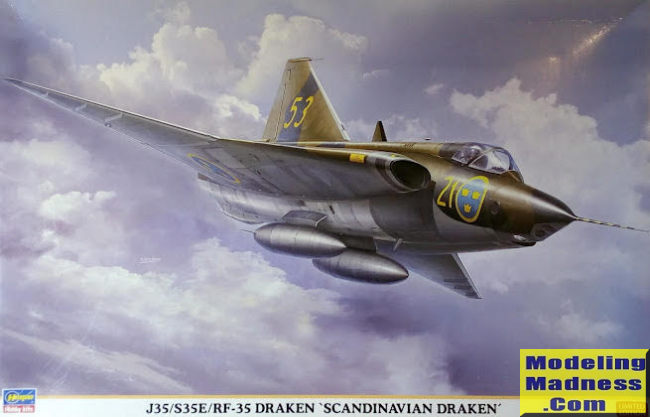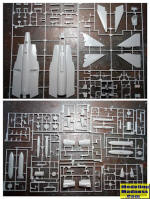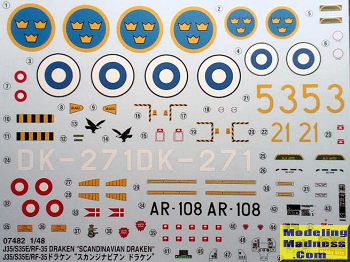
| KIT #: | 07482 |
| PRICE: | 60 euros |
| DECALS: | Three options |
| REVIEWER: | Spiros Pendedekas |
| NOTES: |

| HISTORY |
The “Draken” (“Kite” or “Dragon”) is a
Swedish fighter-interceptor developed and manufactured by Svenska Aeroplan
Aktiebolaget (SAAB) between 1955 and 1974. Development started in 1948 as the
Swedish Air Force future replacement for the then also in development Saab 29
Tunnan and Saab 32B Lansen day and night fighters respectively. It featured an
innovative (but still unproven) double delta wing, which led to the creation of
a sub-scale test aircraft, the Saab 210, which was produced and flown to test
this previously-unexplored aerodynamic feature.
The full-scale production version entered service with frontline squadrons of
the Swedish Air Force on 8 March 1960. It received the designation “Flygplan 35”
and was produced in several variants and types, most commonly as a fighter type
with the prefix “J” (J 35), standing for “Jaktflygplan” (Pursuit-aircraft), the
Swedish term for fighter aircraft.
| THE KIT |
 Hasegawa
hit the bull’s eye when introduced the 1/48 Draken kit in 2008, by providing a
very good kit at a sensible price. It was then only too natural for Hasegawa
(and, by all means, not bad at all) to go for their usual practice and reissue
this kit another 13(!) times till nowadays (2022), practically covering all
versions and most (if not all) schemes worn by this beautiful plane, even the
one featured in “Shin Kazama – Area 88” Japanese anime series! Many of these
reissues are labeled as “Limited Edition”, meaning that it will not be a bad
idea to secure the one you might be interested in. Our Editor has already previewed the
2008 "Austrian Special" limited edition.
Hasegawa
hit the bull’s eye when introduced the 1/48 Draken kit in 2008, by providing a
very good kit at a sensible price. It was then only too natural for Hasegawa
(and, by all means, not bad at all) to go for their usual practice and reissue
this kit another 13(!) times till nowadays (2022), practically covering all
versions and most (if not all) schemes worn by this beautiful plane, even the
one featured in “Shin Kazama – Area 88” Japanese anime series! Many of these
reissues are labeled as “Limited Edition”, meaning that it will not be a bad
idea to secure the one you might be interested in. Our Editor has already previewed the
2008 "Austrian Special" limited edition.
The specific kit is the 2020, also limited edition release, labeled as
“Scandinavian Draken”. It comes in the Hasegawa well-known, very good quality,
big size top opening box, with a dramatic box art of artist T. Hoshino,
portraying a Finnish Draken fighter lightly banking to the left.
Upon opening the box, you are greeted with around 100 light gray styrene parts,
arranged in no less than 15 sprues, of which two of them are big and contain
more or less all basic structural parts, the rest being smaller and contain the
remaining of the parts. Hasegawa’s modular kit design, in order to cater for all
type variants, becomes pretty evident in this kit, as well. Molding is first
class, detail is superbly engraved and I could not spot any flash whatsoever,
with the styrene itself being the high quality typical Hasegawa one (tad on the
hard side, but not really a problem).
The cockpit is nicely detailed with a good looking instrument panel (two
options), seat, stick, throttle grip, rudder pedals and good sidewall details.
No seat belts are provided. Landing gear is also well represented with
sufficient detail. I was pleasantly surprised by the way Hasegawa molded the
distinctively thin and very sensitive intake faces: they are actually protected
by a styrene crate that is molded around them. Thumbs-up here, Hasegawa!
The exhaust nozzle looks believably busy and with good depth. Two types of
external tanks are provided, depending on the version you are building. Per the
(usual and not that favorable) Hasegawa practice, no external ordnance is
provided whatsoever, not even a couple of Sidewinders, so the modeler will have
to source ordnance from elsewhere.
Clear parts are excellently molded and crystal clear. Instructions are nicely
provided as the usual Hasegawa pamphlet, with a comprehensive history at the
front, a parts list and the construction spread in 13 clear steps. Three scheme
options are provided, the first being the Swedish green/blueblack over gray
recon version, the second being the all green Danish recon, with the third being
the Finnish fighter version, carrying the same camo as the Swedish bird. Decals
are superbly printed.
 Instructions
first want you to assemble the cockpit and trap it between the upper and lower
fuselage halves. The next step is quite dense and covers all the main
construction, including the wings, fin and various structural parts. Next is
landing gear, ram air turbine (RAT) and exhaust assembly, followed by another
dense step, where the above subassemblies, plus some other tiny “bits” are to be
installed.
Instructions
first want you to assemble the cockpit and trap it between the upper and lower
fuselage halves. The next step is quite dense and covers all the main
construction, including the wings, fin and various structural parts. Next is
landing gear, ram air turbine (RAT) and exhaust assembly, followed by another
dense step, where the above subassemblies, plus some other tiny “bits” are to be
installed.
Wing tanks assembly is then called for, where you have to choose the correct
ones for the version you are building. The following step includes installation
of wing tanks and what looks like underside pylons. Finally, the seat is to be
assembled and attached, followed by the HUD, the windscreen, the canopy and the
front pitot.
Though there are no complaints regarding the instructions whatsoever, the
modeler has to pay attention at almost all construction steps, in order to
assemble and/or attach the correct parts for the version he is building.
| CONCLUSIONS |
This is another
interesting kit version of the very good Hasegawa quarter scale kit of this
important and highly iconic plane. General shape is good, details are sufficient
and correctly rendered and decals are superbly printed. Some attention has to be
paid during construction, in order to use the correct parts for the version to
be built, with the clear instructions deeming this job easily attainable. No
external weapons are provided, meaning you have to source some if you wish to
arm your Draken.
The kit builds well, this being evident from reading the good number of build
reviews in Modelingmadness archives, with any discovered issues being addressed
by reviewers. Though not for the absolute beginner, modelers with average
experience should have no difficulty putting it together. A lot of aftermarket
stuff seems to be available, as well, in order to beef up the finished model
detail-wise.
Overall, this looks to be a very good kit, still going strong a dozen years
after its initial release. Should you decide to tackle it you will for sure be
rewarded with a great looking Draken.
Happy modeling!
January 2022
Copyright ModelingMadness.com. All rights reserved. No reproduction in part or in whole without express permission.
If you would like your product reviewed fairly and fairly quickly, please contact the editor or see other details in the Note to Contributors.